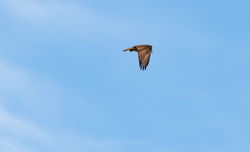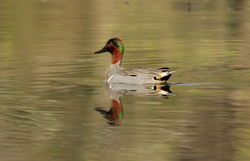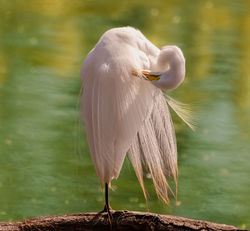
A Year by the River
April 2025
During the month of April, winter’s chill came to an end as spring slowly emerged from its deep, renewing sleep, with the warmer weather awakening the spirit of the Earth. This month, the Bronx River was bustling with activity, enticing me to visit this one particular spot of the River three times. And each visit did not disappoint. Many new visitors, like a Belted Kingfisher and Osprey, were spotted flying above the river one morning early in the month. The Snowy Egret, who I had not witnessed visiting the River during the colder months, returned to this area as did some tiny birds, including warblers, who were busy building homes and scouting for food. Unfortunately, the wood duck I saw earlier in the year was a no show but I did have the opportunity to photograph a Green-Winged Teal and some Mallards.
*Please let me know if I make a mistake with the identification of some of these species.
I use iNaturalist to help.
 Belted KingfisherThe ever elusive Belted Kingfisher. These guys are tricky to get a good photo of! |  Osprey |  Osprey |
|---|---|---|
 Snowy Egret |  Snowy Egret |  Eastern Phoebe |
 Blue-gray Gnatcatcher |  Blue-gray Gnatcatcher |  Blue-gray Gnatcatcher |
 Yellow-rumped Warbler |  Robin in a nest |  American Robin |
 Male Green-Winged TealI was so happy to observe this Green Winged Teal swimming in the Bronx River one morning. I went back a second time to get some better photos of him but he was a bit shy so I didnt linger too long. #Naturefirst |  Green-winged Teal |  Male Mallard |
 Female Mallard |  Female Mallard |  Female Mallard |
One of my visits to the Bronx River was on Easter morning (4/20/2025). I came across this pair of geese standing beside a beautiful white egg just sitting open on the ground without any protection from the environment. Not a very good place to be if you were a goose egg. Although one of the geese looks a little relieved (maybe she popped it out just before i got there), I was perplexed because this egg did not belong where it was. But nature, and the geese, know what to do. So on my merry way I went, leaving the little egg wondering (and knowing) what would happen. The following week I went back to investigate. I am not sure who or what did it but the egg was cracked open near the spot where it was left.
 Canadian GeeseTwo canadian geese are standing beside an egg. |  Goose eggWhatchya doing here little egg? |  Goose eggI am assuming this is a goose egg but in reality, i do not know for sure. It could also be a duck egg but I believe those are smaller. |
|---|---|---|
 Cracked open Goose eggWas there even a live creature living inside the egg? If so, did it survive? Only the River knows. |

These are not goose eggs. These are plastic eggs left by a careless someone near the home of a muskrat and other animals who call the Bronx River home.

The first month of spring at the Bronx River brought stories of growth, awe, and lots of life.

Although I probably shouldn't have, I have saved my favorites photos from April for last. So if you have made it all the way down to this point of the page, thank you. This part gets a little nerdy and technical.
These two images are actually the same photo however, the first photo on the left is the final edit and the photo on the right is the original .NEF file.
Capturing images in a NEF file format, rather than in JPEG format, is known in the photography world as "shooting in raw". There are many benefits to shooting in raw. First, the NEF file contains all the original data captured by the camera. This means that you retain all the quality and details of the image. In addition, when a photograph is taken in JPEG format, the images are compressed and processed in-camera, which denies a serious photographer real creative freedom. Shooting in raw gives a photographer full control over their images especially during the creative editing process that comes after because editing raw files provides more flexibility.
So how did I change the original photo to the final edit? With the point color tool in Lightroom Classic. This tool helps elevate colors in your photos in ways that shooting in raw only provides (if you know, you know).

Finally, these snowy egret photos were adjusted using the hue and tone tools in Lightroom Classic. Which is your favorite?
 |  |  |
|---|---|---|
 |  |









